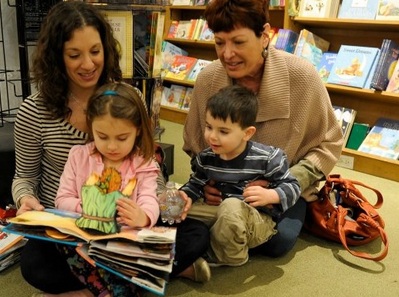 Summer is a wonderful time to reinforce a family culture of storytelling and story sharing. We were thrilled (but not surprised) that in their quest to find ways to make families work more effectively, researchers at Emory University concluded that "the single most important thing you can do for your family may be the simplest of all: develop a strong family narrative."
Summer is a wonderful time to reinforce a family culture of storytelling and story sharing. We were thrilled (but not surprised) that in their quest to find ways to make families work more effectively, researchers at Emory University concluded that "the single most important thing you can do for your family may be the simplest of all: develop a strong family narrative."
Stories build resilience and give us sustenance and comfort in challenging times. Besides that, collecting stories is joyful and fun and connects us all to one another. Here are 10 ways to build your family narrative.
1. Create a Family Mission Statement
This is a wonderful opportunity to discuss what you value as a family. Make your children’s opinions and ideas central in this exercise. After crafting a succinct statement, decide together where you will record the mission statement, where you will display it, and how you will translate the ideas into concrete action.
2. Unleash Your Inner Oprah
We define literacy as reading, writing, speaking and listening. Conducting interviews in a relaxed and comfortable setting is a great way to boost speaking and listening skills. Seek out family memories and stories from your relatives – grandparents, great aunts, cousins, and even the family pet might have a secret to reveal! Have your child brainstorm interesting questions and decide how you will record the interviewee’s answers. We recommend publishing the interviews to keep as a memento and to demonstrate the importance of putting individual stories on record.
3. Read Aloud Every Day
Daily read alouds are one of the most powerful and precious gifts you and your children can give to each other. Vary the material that you read aloud to expose your children to a wide genre of text, from newspaper articles to poetry to picture books to graphic novels. A fun way to gather read aloud material is to go on library scavenger hunts. Make a list of topics of interest to your family that you want to learn more about and hunt for books that will satisfy your curiosities.
4. Use the Rose, Bud and Thorn Activity to Uncover Noteworthy Events
Our teen LitClub sessions always begin with a short check-in activity called “Rose, Bud, and Thorn.” Everyone takes a turn sharing a rose (something positive that happened during the week) a thorn (something that was frustrating or challenging) and a bud (a goal or something to look forward to in the future). This activity is a quick way to gain important insights into your child’s life, and is an opportunity for them to hear more about your own goals, and to hear how you overcome your challenges.
5. Keep a Family Inspiration Notebook
Keeping track of the sights, sounds, photos, books and songs that inspire and delight your family members is a wonderful way to encourage curious world explorers. Keep the notebook in a place that is easy for everyone to access and emphasize that all forms of expression and documentation are welcome. Drawings, quotes, poems, and longer written reflections will make your notebook a one-of-a-kind piece of art.
6. Say Cheese
Visual literacy and close reading pictures is critical in a world that is constantly generating and curating digital content. Take advantage of the image-based social media platforms such as Pinterest, Flickr and Instagram to document special moments and capture the world from each family member's unique perspective. If you prefer to keep this content offline, compile a photo archive in a scrapbook or on a photo wall. Challenge your children to summarize the significance of each photo with a short, snappy caption.
7. Go Global
With access to information at our fingertips (and in our pockets thanks to mobile technology!) we are perfectly poised to cultivate global citizens from the earliest age. Shift your child's perspective from local to global by researching what life is like for families around the world. What seems similar about families in another country? What looks different? Why? Try to build real connections and dialogue through Twitter. Short, inquisitive tweets can start a conversation that can transform into virtual friendships and lifelong connections.
8. Serve Your Community Together
Find a local organization (use your mission statement as a guide) and volunteer as a family. Remember to debrief regularly about the work you are doing together, and reinforce the positive impact you are creating in the world. Encourage your children to be community leaders by asking them what they would like to change about their community, and make an action plan outlining what it will take to create this change.
9. Adopt a Gratitude Attitude
Expressing gratitude and identifying the things that we are grateful for (however small) foster optimism, compassion and hope. Keep a chart on the wall or the fridge and fun markers and pens that your children can use to document what they love about their family. Keeping this chart in a visible, reachable place that children can easily go to when a thought crosses their mind will make finding and communicating gratitude second nature.
10. Read for the Record Together
Reading aloud is important, but so is independent reading time. However, "independent" does not mean "alone." Set aside time each day to nurture your individual reading lives. You may have a grassy patch in the backyard, or a cozy living room where you can pass half an hour (or longer) in companionable silence. Write short reviews and recommendations for each other after as you finish a book, and don't forget to log these reading in the Scholastic Summer Reading Challenge!
